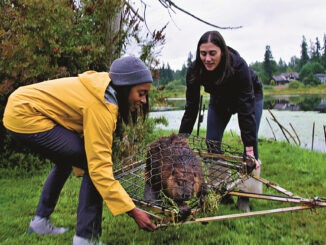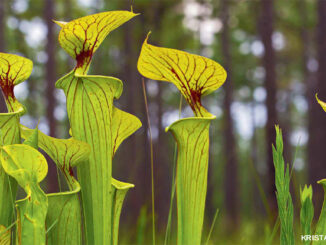
Piranhas
By Kathy KrankingThe mouthful of choppers above belongs to a red-bellied piranha. Below, you can see a school of red-bellies. They are one of the few kinds of piranhas that can sometimes be dangerous to people.
These toothy fishes have a BIG bite and a BAD reputation.
You may have heard scary stories about piranhas (pihr-AH-nuhz). These fishes have razor sharp teeth and super-strong jaws. They’re often thought of as bloodthirsty killers, attacking other animals and even people! But do they really live up to their deadly image? Well, yes and no. But mostly, no.
So here’s the thing about piranhas: Although they do deserve some of their scary reputation, a lot of it is exaggerated. The piranha’s bad rap got its start in the early 1900s, when President Theodore Roosevelt visited South America (see map on page 31). After seeing a group of piranhas attack an animal, President Roosevelt described them as vicious killers. But it turned out that the fish had been kept in a small pool of water without food for days. They were starving, so they went crazy when they finally got food. But the image of piranhas as bloodthirsty “eating machines” has continued, showing up in stories, movies, and even video games.
The Toothy Truth
The true story about piranhas, though, is usually not so dramatic. Piranhas live mostly quiet lives in lakes, streams, and rivers. Depending on the species, they feed on insects, snails, fruit, seeds, and things they find that are already dead. A few kinds will ambush smaller fishes and gobble them up. But many kinds of piranhas get much of their food by just nipping at fishes’ tails and then swimming away with a mouthful of tail fin. So despite their fierce reputation, most piranhas are actually just a bunch of pesky fin-nippers!
Bite Club
But wait . . . there are certain times that a few species, especially the red-bellied piranha—the one usually seen in stories and movies—can be dangerous. For example, during the dry season, ponds and lakes have less water in them, so they become smaller. This means there are lots of piranhas in a smaller area, so there’s more competition for food. When that happens, piranhas can live up to their image, attacking anything that enters the water in what’s called a “feeding frenzy.” During the attack, the water looks as if it’s boiling, with fish darting in to take a bite, then moving away as other fish come forward to eat. The piranhas get so excited, they’ll even take bites out of each other! If people entered the water in these conditions, they would likely get bitten.
Jaws Junior
Another time that piranhas can be dangerous is when they’re protecting their eggs or young. Some species lay their eggs on a river bottom or among plants. Then the male guards them, attacking anything that comes near.
Also, people who fish for piranhas and then handle them carelessly can be bitten. But attacks on humans by piranhas are still rare, and people often swim without getting bitten in waters where piranhas live.
The truth is, people are a lot more dangerous to piranhas than piranhas are to people. People catch piranhas and cook them to eat—they even use them to make piranha soup! If they don’t eat them, they stuff them to sell to tourists. They sell toothy piranha jaws, as well.
Snack Pack
Part of the image of piranhas attacking in a pack comes from the fact that they often stay together in a group. The truth is that they do this not to attack prey, but to stay safe from enemies. Lots of animals like to eat piranhas, including crocodiles, river dolphins, large fish, storks, egrets, and others. To them, piranhas aren’t scary at all!
So now you know the real story of piranhas—the facts and the fiction!



















